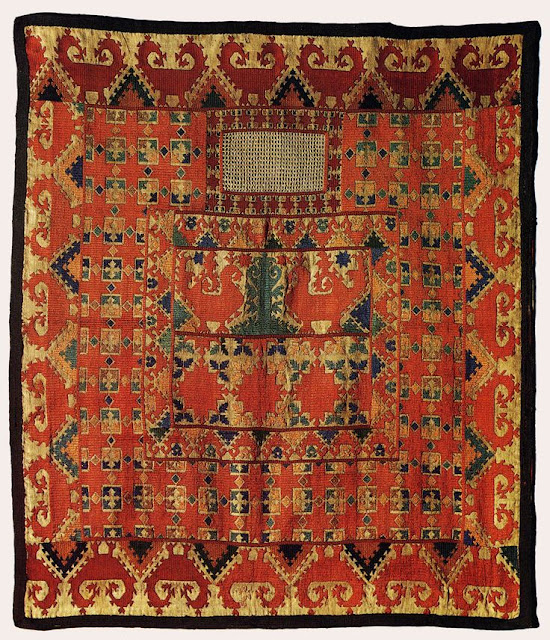Hello all,
Today I will talk about one of the more striking embroidery traditions of Central Asia.
These bridal veils are widely found in collections and museums, and the work is extraordinary.
The above example is found in the Museum of the Ethnography of the Peoples of the USSR, or whatever it is called these days, in St. Petersburg .
Tajikistan is now an independent nation in the south of Central Asia.
https://en.wikipedia.org/wiki/Tajikistan
Its Capitol is Dushanbe, and this is their flag.
In contrast to most of Central Asia, which is Turkic, The Tajiks are an Iranian people, and their language is a form of Persian. https://en.wikipedia.org/wiki/Tajiks
They inhabit not only Tajikistan, but parts of the neighboring countries, in particular the north of Afghanistan. The easternmost portion of Tajikistan consists of Кӯҳистони Бадахшон or Gorno Badakhshan, where the people speak the various Pamir languages. https://en.wikipedia.org/wiki/Gorno-Badakhshan_Autonomous_Region
These extend also into northeastern Afghanistan and Uyguristan in China, which immediately border it.
These veils, while often taken to be emblematic of Tajikistan as a whole, are in fact from only one small district, Darvaz. It is shown in dark red on this map.
.
This garment featured prominently in the ceremonial procession of the Bride to her new husband's house, and the first viewing of the bride by the family. They were then displayed by the family and used in subsequent generations.
They all have substantially the same general composition. Here is a drawing of another veil. Click to enlarge.
There is a panel towards the upper center of the veil where the threads are bundled with a faggoting stitch to form an area of coarser grid so that the bride may see. Of the above two examples, one has this area plain, and the other has it embroidered. The edge is ornamented with stylized Birds; Peacocks perhaps, or Roosters. A pair of these birds is also placed below the eye holes. The rest of the veil is composed of various rectangular fields with diamonds, suns, crosses and other geometric shapes.
The embroidery is done with a satin stitch which takes a back stitch every few threads, and so is able to make these large figures without being in danger of catching. Here above is a closeup of both the front and the back of this stitch.
There is a hand woven band attached to the upper edge of the veil, usually with tassels attached. Presumably this is to tie the veil around the head, or more likely, a headdress of some sort, perhaps something like this.
This is often missing in collected pieces. I have found no images of a bride actually wearing one of these, but presumably it was worn something like this.
Today in this region the same type of embroidery is used to make curvilinear designs on the women's tunic or kurta, as shown here.
But there is evidence that in the past, the embroidery on the rest of the clothing was more similar to that of the veils.
The use of these veils died out around the beginning of the 20th cent., but they were kept and prized as great examplars of the art of these people. Here are images of other such pieces.
The embroidery on this veil is very similar to the tunic in the drawing above.
Thank you for reading, I hope that you have found this to be interesting and informative
Roman K.
email: rkozakand@aol.com
Source Material:
N. N. Ershov & Z. A. Shirokova, 'Al'bom Odezhdy Tadzhikov', Dushanbe, 1969
Sophia Avizhanskaya, 'Museum of the Ethnography of the Peoples of the USSR', Leningrad, 1990
Tatyana RAzina, 'Folk Art in the Soviet Union', Leningrad, 1990



































